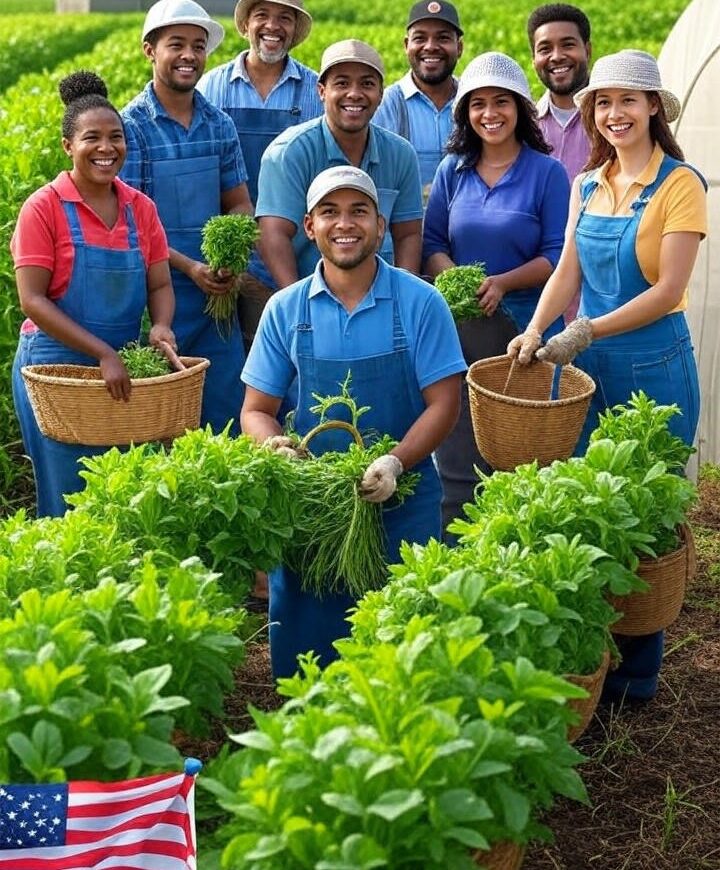The United States’ agricultural sector, a cornerstone of its $21 trillion economy, produces $1.5 trillion in annual output, accounting for 18% of global agricultural exports, according to the U.S. Department of Agriculture (USDA).
Employing over 2.6 million farmworkers, the industry faces a persistent labor shortage, with 60% of farmers reporting difficulties finding workers in 2024, per the National Farm Bureau.
This gap, driven by an aging workforce, declining domestic interest, and seasonal demand, has led employers to sponsor foreign workers through the H-2A temporary agricultural visa program.
Farm jobs offer wages of $26,000-$42,000 annually, opportunities in states like California, Washington, and Florida, and benefits like free housing and transportation.
This guide explores farm jobs in the USA with visa sponsorship in 2025, detailing the job market, visa processes, requirements, application strategies, benefits, responsibilities, and challenges.
Drawing on data from the Bureau of Labor Statistics (BLS), U.S. Department of Labor (DOL), U.S. Citizenship and Immigration Services (USCIS), and industry sources, it provides a roadmap for foreign workers to thrive in America’s agricultural heartland.
Farmworkers, classified under SOC 45-2092, are essential for planting, harvesting, and maintaining crops and livestock across farms, ranches, and orchards. Employers like Sakuma Brothers Farms, Grimm Family Farms, and Farmers Cooperative are actively sponsoring H-2A workers to address shortages, particularly during peak seasons.
The H-2A visa, with no annual cap and over 390,000 certifications in 2024, enables workers from countries like Mexico, Jamaica, and Guatemala to secure roles. This article equips aspiring farmworkers with the tools to navigate the job market, obtain sponsorship, and succeed, whether picking berries in Washington or tending livestock in Wisconsin.
The Farm Job Market in the USA 2025
Overview and Trends
The U.S. agricultural industry spans 2 million farms, covering 900 million acres, and generates $450 billion in direct revenue, per USDA. The BLS projects 141,800 annual farmworker openings through 2032, driven by:
- Labor Shortages: Only 40% of farm jobs are filled by U.S. workers, with 1.2 million positions vacant in 2024 (Farm Bureau).
- Seasonal Demand: Peak harvests (spring/summer) require temporary labor, with 70% of H-2A jobs tied to seasonal cycles.
- Crop Diversity: High-value crops like berries, vegetables, and tree nuts, which rely on hand labor, drive demand.
- Aging Workforce: 55% of farmworkers are over 45, accelerating turnover.
- Immigration Policies: H-2A program expansion supports 15% annual growth in certifications.
High-Demand Roles and Locations
Farm roles include:
- Crop Workers: Plant, weed, prune, and harvest fruits, vegetables, and grains.
- Livestock Workers: Feed, herd, and care for cattle, poultry, or swine.
- Equipment Operators: Drive tractors, harvesters, or irrigation systems.
- Farm Laborers: Perform general tasks like fence repair or packing produce.
- Specialized Roles: Nursery workers or beekeepers, requiring niche skills.
Top states for visa-sponsored farm jobs:
- California: 120,000 H-2A certifications in 2024, with roles in Fresno, Salinas, and Bakersfield.
- Washington: 40,000 certifications, centered in Yakima and Wenatchee.
- Florida: 35,000 certifications, with demand in Immokalee and Plant City.
- Georgia: Roles in Vidalia and Tifton.
- North Carolina: Tobacco and vegetable farms in Wilson and Raleigh.
Wages and Employers
- Median Wage: $31,200/year ($15/hour) for farmworkers; specialized roles earn $36,000-$42,000 (BLS, 2024).
- Entry-Level: $26,746; experienced workers earn up to $42,840.
- Overtime: 1.5x pay adds $1,000-$3,000 during peak seasons.
- Major Employers:
- Sakuma Brothers Farms (Washington): Berry production, hiring 4,000 H-2A workers annually.
- Grimm Family Farms (Wisconsin): Dairy and vegetables, employing 200 H-2A workers.
- Farmers Cooperative: Nationwide, offering equitable roles with sponsorship.
- Cargill: Hires for crop and livestock roles with H-2A support.
- USA Farm Labor: Agency connecting 1,400 farmers with H-2A workers.
- Small Farms: Family-owned operations in California and Florida.
Job boards like Indeed (6,284 farm jobs with sponsorship), SimplyHired (286 jobs), and SeasonalJobs.dol.gov (500+ H-2A listings) offer opportunities, with hiring peaks in spring (March-May) and fall (September-November). Basic English is often sufficient, with Spanish valued in regions like California. The next section details visa options.
Visa Options for Farm Jobs
Foreign farmworkers primarily rely on the H-2A visa, as other visas like EB-3 or H-1B are less applicable. Below is an overview based on USCIS and DOL guidelines.
H-2A Visa (Temporary Agricultural Worker)
- Purpose: For temporary or seasonal agricultural jobs when U.S. workers are unavailable, such as harvesting or planting.
- Cap: No annual cap; 390,762 certifications in FY 2024, with 2025 expected to exceed 400,000 (DOL).
- Duration: Up to 10 months, extendable to 3 years, with a 60-day return home required.
- Eligibility: Job offer from a DOL-approved employer, country eligibility, and intent to return.
- Process:
- Employer files a job order with the State Workforce Agency (60-75 days before start).
- Employer secures Temporary Labor Certification (Form ETA-9142A) via DOL’s FLAG system (45 days prior).
- Employer submits Form I-129 ($1,500 fee, employer-paid).
- Worker applies for an H-2A visa at a U.S. embassy/consulate.
- Processing Time: 60-75 days (2-4 weeks for visa, 45-60 days for certification). Emergency filing reduces to 45 days.
- Benefits: Free housing, transportation (to/from home country and worksite), and wages above federal minimum ($15.81-$19.75/hour by state). No prohibited fees (e.g., recruitment costs) per 8 CFR 214.2(h)(5)(xi).
- Limitations: Temporary; no direct path to permanent residency.
Other Visa Options
- EB-3 Visa: Rare for farmworkers due to low skill requirements; used for permanent roles like farm managers.
- H-2B Visa: For non-agricultural roles (e.g., landscaping), not farm work.
- J-1 Visa: For agricultural training programs, not primary farm labor.
- TN Visa: For NAFTA professionals (e.g., agronomists), not laborers.
The H-2A is the dominant pathway, with 98% of visa-sponsored farm jobs using it, per DOL data. The next section outlines worker requirements.
Requirements for Foreign Farmworkers
To secure H-2A farm jobs, foreign workers must meet USCIS, DOL, and employer criteria.
- Country Eligibility:
- Applicants must be from H-2A-eligible countries (e.g., Mexico, Jamaica, Guatemala, South Africa). The 2025 Federal Register lists over 90 nations.
- Job Offer: A formal offer from a U.S. employer with approved labor certification, specifying farm duties (e.g., harvesting, livestock care).
- Education and Training:
- No formal education required; literacy is a plus for equipment roles.
- No certifications needed, but training in farming (e.g., planting, animal husbandry) strengthens applications.
- Some employers provide on-site training (e.g., pesticide safety, tractor operation).
- Experience:
- 0-1 year of farm work or related experience (e.g., gardening, ranching).
- Evidence includes employer letters or work records.
- English Proficiency: Basic English or Spanish for safety and communication with supervisors. Employers assess during interviews; consular officers verify.
- Intent to Return: Proof of home country ties (e.g., family, property) to ensure return after visa expiration.
- Health and Background:
- Clean criminal record (police certificate from home country and residences over 6 months).
- Health exams, including vaccinations ($100-$300).
- Physical ability to perform strenuous tasks (e.g., lifting 50 pounds, standing 8 hours).
A valid passport and initial financial stability are required, though employers cover travel ($500-$2,000), housing, and visa fees ($375-$395). Preparing references early enhances applications.
The Job Search and Visa Application Process
Securing a visa-sponsored farm job involves job hunting, application preparation, and visa processing. Below is a roadmap for 2025.
Step 1: Research and Find Jobs
- Job Portals:
- Indeed: 6,284 farm jobs with sponsorship, filterable by “H-2A visa.”
- SimplyHired: 286 jobs, including roles at Cargill and AgReserves.
- SeasonalJobs.dol.gov: 500+ H-2A listings, directly from DOL.
- FarmJobSearch: Specialized for agricultural roles.
- AgCareers.com: Lists roles for various skill levels.
- Recruitment Agencies:
- USA Farm Labor: Connects 1,400 farmers with H-2A workers.
- H-2A Employers Association: Guides workers through DOL processes.
- Farmers Cooperative: Recruits for member farms.
- Fees ($500-$1,500) are employer-paid.
- Employer Websites: Sakuma Brothers, Grimm Family Farms, and Cargill post H-2A roles.
- Networking: Join LinkedIn groups (“Farm Jobs USA”), Reddit’s r/Agriculture, or contact farmers directly via state Farm Bureau sites.
Step 2: Prepare Application Materials
- Resume: Highlight farm experience, physical stamina, and visa eligibility (e.g., “Eligible for H-2A sponsorship”).
- Cover Letter: Emphasize work ethic (e.g., “I am a dedicated farmworker with 1 year of harvesting experience, seeking H-2A sponsorship”).
- Documents: Provide references, work records, and translated certificates ($50-$100/document).
Step 3: Apply and Interview
- Applications: Submit via portals or employer websites. Follow up within 7-10 days.
- Interviews: Expect questions on physical ability (e.g., “Can you work long hours outdoors?”) and visa knowledge. Practice basic English or Spanish responses. Remote interviews need stable internet; in-person interviews require neat attire (e.g., work boots, jeans).
- Job Offer: The employer provides a contract, initiating the visa process.
Step 4: Apply for H-2A Visa
- Employer Steps:
- File job order with State Workforce Agency (60-75 days prior).
- Secure labor certification (30-45 days).
- Submit Form I-129 (15-30 days).
- Worker Steps:
- Submit Form DS-160 at a U.S. embassy, paying $190 visa fee and $185-$205 processing costs.
- Provide:
- Passport and photos
- Form I-797 (I-129 approval)
- Job offer letter
- Proof of home ties
- Criminal record certificate
- Attend consular interview (5-10 minutes) on job details and intent to return (2-4 weeks processing).
- Entry: Enter the U.S. within 10 days of job start.
Step 5: Start Employment
- Employers provide training (e.g., safety, equipment use) and housing. Begin work within 10 days.
An agency like USA Farm Labor or an immigration attorney ($1,000-$2,500) can assist, though self-application is common.
Benefits and Responsibilities
H-2A farm jobs offer notable benefits, balanced by responsibilities.
Benefits
- Wages: $26,000-$42,000/year, with overtime adding $1,000-$3,000.
- Visa Sponsorship: H-2A ensures legal work for up to 10 months, extendable to 3 years.
- Free Housing: Employer-provided, meeting DOL standards (e.g., clean, furnished).
- Transportation: Reimbursed travel ($500-$2,000) and worksite commuting.
- Labor Protections: U.S. labor laws ensure fair wages and conditions.
- Career Growth: Experience leads to roles like farm supervisor ($40,000-$50,000) or equipment specialist. Certifications (e.g., ASFMRA’s Accredited Farm Manager) enhance prospects.
- Community: Engage in rural communities through festivals and cooperative events.
- U.S. Experience: Improves skills and employability, with 80% of H-2A workers reporting benefits.
Responsibilities
- Visa Compliance: Work only for the sponsor; overstaying risks a 3-10-year ban.
- Performance: Meet farm standards (e.g., harvest quotas, animal care protocols).
- Taxes: Pay federal/state taxes (10-20%, $2,600-$8,400 on $31,200 salary). File Form 1040NR.
- Safety: Follow OSHA guidelines (e.g., pesticide handling, equipment safety).
- Reporting Abuse: Contact DOL’s Wage and Hour Division (1-866-487-9243) for violations.
Challenges and Strategies
- Physical Demands: Prepare for long hours and heavy lifting with exercises like squats or stamina training.
- Language: Improve basic English or Spanish via Duolingo or local classes ($50-$200).
- Living Costs: Budget $1,000-$2,000/month in rural areas, as housing is free but food and personal expenses remain.
- Scams: Verify employers via DOL’s H-2A database or Farm Bureau; avoid upfront payments.
- Isolation: Combat rural isolation by joining community events or online groups like r/Agriculture.
- Visa Processing: Apply 4-6 months early, as delays are common.
Additional Strategies
- Target Seasonal Roles: Spring/fall harvests (e.g., berries in Washington, citrus in Florida) have high H-2A demand.
- Leverage Agencies: USA Farm Labor and H-2A Employers Association streamline applications.
- Network: Connect with H-2A workers on Reddit or LinkedIn for referrals, valued by 20% of employers.
- Prepare for Interviews: Practice questions (e.g., “Why do you want to work on a U.S. farm?”) and emphasize physical readiness.
- Monitor Updates: Check USCIS and DOL for H-2A policy changes, as demand may increase certifications.
Conclusion
Farm jobs in the USA with visa sponsorship offer foreign workers a chance to join a vital industry in 2025. With 1.2 million vacancies, wages of $26,000-$42,000, and over 400,000 H-2A certifications, roles at employers like Sakuma Brothers and Farmers Cooperative are within reach.
Start by exploring Indeed, leveraging agencies like USA Farm Labor, and preparing work records. Navigate the H-2A process with care, excel in farm tasks, and build a future in regions like California or Washington.
Apply early, verify employers, and seize this opportunity to contribute to America’s agricultural backbone. Whether harvesting apples in Yakima or tending cattle in Wisconsin, your role as a farmworker can be a foundation for growth




